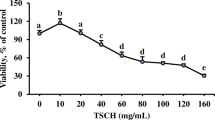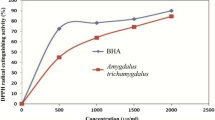Abstract
Antioxidant activities of protein hydrolysate prepared from Nile tilapia protein isolate using Alcalase (HA), Alcalase followed by papain (HAPa) and their Sephadex G-25 fractions (FHA and FHAPa) were investigated in both chemical and cellular based models. Amongst all samples, FHAPa showed the highest chemical antioxidant activities, however it had no metal chelation activity. Cellular antioxidant ability of HA, HAPa and their fractions against H2O2 and AAPH induced oxidative damage of HepG2 cell and DNA were tested. When cells were pretreated with all hydrolysates or fractions at different concentrations (0.5–2 mg/mL) in the absence and presence of 50 μM Trolox, cell viability was in the range of 91.10–111.40 %. However, no difference in cell viability was observed among samples having various concentrations (P > 0.05). Cell reactive oxygen species (ROS) generation as mediated by H2O2 and AAPH decreased with treatment of hydrolysates or their fractions, especially in combination with 50 μM Trolox. FHAPa effectively inhibited H2O2 and peroxyl radical induced DNA scission in a dose dependent manner. Therefore, Nile tilapia protein hydrolysates could serve as a functional food ingredient.



Similar content being viewed by others
References
Benjakul S, Morrissey MT (1997) Protein hydrolysates from Pacific whiting solid wastes. J Agric Food Chem 45(9):3423–3430
Benzie IF, Strain J (1996) The ferric reducing ability of plasma (FRAP) as a measure of “antioxidant power”: the FRAP assay. Anal Biochem 239(1):70–76
Binsan W, Benjakul S, Visessanguan W, Roytrakul S, Tanaka M, Kishimura H (2008) Antioxidative activity of mungoong, an extract paste, from the cephalothorax of white shrimp (Litopenaeus vannamei). Food Chem 106(1):185–193
Chai HJ, Chan YL, Li TL, Shiau CY, Wu CJ (2013) Evaluation of lanternfish (Benthosema pterotum) hydrolysates as antioxidants against hydrogen peroxide induced oxidative injury. Food Res Int 54(1):1409–1418
Chandrasekara A, Shahidi F (2011) Inhibitory activities of soluble and bound millet seed phenolics on free radicals and reactive oxygen species. J Agric Food Chem 59(1):428–436
Chen HM, Muramoto K, Yamauchi F, Nokihara K (1996) Antioxidant activity of designed peptides based on the antioxidative peptide isolated from digests of a soybean protein. J Agric Food Chem 44(9):2619–2623
Choe E, Min DB (2005) Chemistry and reactions of reactive oxygen species in foods. J Food Sci 70(9):R142–R159
Elisia I, Kitts DD (2008) Anthocyanins inhibit peroxyl radical-induced apoptosis in Caco-2 cells. Mol Cell Biochem 312(1–2):139–145
García-Nebot MJ, Recio I, Hernández-Ledesma B (2014) Antioxidant activity and protective effects of peptide lunasin against oxidative stress in intestinal Caco-2 cells. Food Chem Toxicol 65:155–161
Guo H, Kouzuma Y, Yonekura M (2009) Structures and properties of antioxidative peptides derived from royal jelly protein. Food Chem 113(1):238–245
Halldorsdottir SM, Sveinsdottir H, Freysdottir J, Kristinsson HG (2014) Oxidative processes during enzymatic hydrolysis of cod protein and their influence on antioxidant and immunomodulating ability. Food Chem 142:201–209
Himaya S, Ryu B, Ngo DH, Kim SK (2012) Peptide Isolated from Japanese flounder skin gelatin protects against cellular oxidative damage. J Agric Food Chem 60(36):9112–9119
Je JY, Lee KH, Lee MH, Ahn CB (2009) Antioxidant and antihypertensive protein hydrolysates produced from tuna liver by enzymatic hydrolysis. Food Res Int 42(9):1266–1272
Je JY, Qian ZJ, Lee SH, Byun HG, Kim SK (2008) Purification and antioxidant properties of bigeye tuna (Thunnus obesus) dark muscle peptide on free radical-mediated oxidative systems. J Med Food 11(4):629–637
Kim GN, Kwon YI, Jang HD (2011) Protective mechanism of quercetin and rutin on 2,2′-azobis(2-amidinopropane)dihydrochloride or Cu2+-induced oxidative stress in HepG2 cells. Toxicol in Vitro 25(1):138–144
Kim SY, Je JY, Kim SK (2007) Purification and characterization of antioxidant peptide from hoki (Johnius belengerii) frame protein by gastrointestinal digestion. J Nutr Biochem 18(1):31–38
Kittiphattanabawon P, Benjakul S, Visessanguan W, Shahidi F (2012) Gelatin hydrolysate from blacktip shark skin prepared using papaya latex enzyme: antioxidant activity and its potential in model systems. Food Chem 135(3):1118–1126
Kittiphattanabawon P, Benjakul S, Visessanguan W, Shahidi F (2013) Inhibition of angiotensin converting enzyme, human LDL cholesterol and DNA oxidation by hydrolysates from blacktip shark gelatin. LWT Food Sci Technol 51(1):177–182
Klompong V, Benjakul S, Yachai M, Visessanguan W, Shahidi F, Hayes KD (2009) Amino acid composition and antioxidative peptides from protein hydrolysates of yellow stripe trevally (Selaroides leptolepis). J Food Sci 74(6):C126–C133
Lima CF, Fernandes-Ferreira M, Pereira-Wilson C (2006) Phenolic compounds protect HepG2 cells from oxidative damage: relevance of glutathione levels. Life Sci 79(21):2056–2068
Mendis E, Rajapakse N, Byun HG, Kim SK (2005) Investigation of jumbo squid (Dosidicus gigas) skin gelatin peptides for their in vitro antioxidant effects. Life Sci 77(17):2166–2178
Owuor ED, Kong ANT (2002) Antioxidants and oxidants regulated signal transduction pathways. Biochem Pharmacol 64(10):765–770
Poli G, Leonarduzzi G, Biasi F, Chiarpotto E (2004) Oxidative stress and cell signalling. Curr Med Chem 11(9):1163–1182
Qian ZJ, Jung WK, Kim SK (2008) Free radical scavenging activity of a novel antioxidative peptide purified from hydrolysate of bullfrog skin, Rana Catesbeiana Shaw. Bioresour Technol 99(6):1690–1698
Raghavan S, Kristinsson HG (2008) Antioxidative efficacy of alkali-treated tilapia protein hydrolysates: a comparative study of five enzymes. J Agric Food Chem 56(4):1434–1441
Ren J, Zhao M, Shi J, Wang J, Jiang Y, Cui C, Kakuda Y, Xue SJ (2008) Purification and identification of antioxidant peptides from grass carp muscle hydrolysates by consecutive chromatography and electrospray ionization-mass spectrometry. Food Chem 108(2):727–736
Robinson HW, Hogden CG (1940) The biuret reaction in the deter serum proteins. J Biol Chem 135(2):707–725
Saiga A, Tanabe S, Nishimura T (2003) Antioxidant activity of peptides obtained from porcine myofibrillar proteins by protease treatment. J Agric Food Chem 51(12):3661–3667
Samaranayaka AG, Kitts DD, Li-Chan ECY (2010) Antioxidative and angiotensin-I-converting enzyme inhibitory potential of a Pacific hake (Merluccius productus) fish protein hydrolysate subjected to simulated gastrointestinal digestion and Caco-2 cell permeation. J Agric Food Chem 58(3):1535–1542
Samaranayaka AG, Li-Chan EC (2011) Food-derived peptidic antioxidants: a review of their production, assessment, and potential applications. J Funct Foods 3(4):229–254
Steel RGD, Torrie JH (1980) Principles and procedures of statistics: a biometrical approach. McGraw-Hill, New York
Surguladze N, Thompson KM, Beard JL, Connor JR, Fried MG (2004) Interactions and reactions of ferritin with DNA. J Biol Chem 279(15):14694–14702
Theodore AE, Raghavan S, Kristinsson HG (2008) Antioxidative activity of protein hydrolysates prepared from alkaline-aided channel catfish protein isolates. J Agric Food Chem 56(16):7459–7466
Wang B, Gong YD, Li ZR, Yu D, Chi CF, Ma JY (2014) Isolation and characterisation of five novel antioxidant peptides from ethanol-soluble proteins hydrolysate of spotless smoothhound (Mustelus griseus) muscle. J Funct Foods 6:176–185
Wijeratne SS, Cuppett SL, Schlegel V (2005) Hydrogen peroxide induced oxidative stress damage and antioxidant enzyme response in Caco-2 human colon cells. J Agric Food Chem 53(22):8768–8774
Wiriyaphan C, Chitsomboon B, Yongsawadigul J (2012) Antioxidant activity of protein hydrolysates derived from threadfin bream surimi byproducts. Food Chem 132(1):104–111
Yarnpakdee S, Benjakul S, Kristinsson H, Kishimura H (2014) Antioxidant and sensory properties of protein hydrolysate derived from Nile tilapia (Oreochromis niloticus) by one- and two-step hydrolysis. J Food Sci Technol. doi:10.1007/s13197-014-1394-7
You L, Zhao M, Regenstein JM, Ren J (2011) In vitro antioxidant activity and in vivo anti-fatigue effect of loach (Misgurnus anguillicaudatus) peptides prepared by papain digestion. Food Chem 124(1):188–194
Zhang QX, Ling YF, Sun Z, Zhang L, Yu HX, Kamau SM, Lu RR (2012) Protective effect of whey protein hydrolysates against hydrogen peroxide-induced oxidative stress on PC12 cells. Biotechnol Lett 34(11):2001–2006
Zhang SB, Wang Z, Xu SY (2008) Antioxidant and antithrombotic activities of rapeseed peptides. J Am Oil Chem Soc 85(6):521–527
Zhu L, Chen J, Tang X, Xiong YL (2008) Reducing, radical scavenging, and chelation properties of in vitro digests of Alcalase-treated zein hydrolysate. J Agric Food Chem 56(8):2714–2721
Acknowledgments
This research was supported by the Thailand Research Fund under the Royal Golden Jubilee Ph.D. Programme to Suthasinee Yarnpakdee (PHD/0226/2552) and the Grant-in-Aid for dissertation from Graduate School, Prince of Songkla University, Thailand. Matis Ltd-Icelandic Food and Biotech R & D in Reykjavik and Matis-Biotechnology Centre in Saudarkrokur were also acknowledged for instrument support and their facilities. The TRF Distinguished Research Professor Grant was also acknowledged.
Author information
Authors and Affiliations
Corresponding author
Rights and permissions
About this article
Cite this article
Yarnpakdee, S., Benjakul, S., Kristinsson, H.G. et al. Preventive effect of Nile tilapia hydrolysate against oxidative damage of HepG2 cells and DNA mediated by H2O2 and AAPH. J Food Sci Technol 52, 6194–6205 (2015). https://doi.org/10.1007/s13197-014-1672-4
Revised:
Accepted:
Published:
Issue Date:
DOI: https://doi.org/10.1007/s13197-014-1672-4




